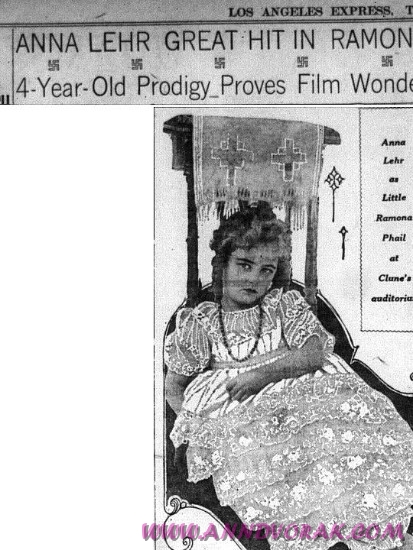Ann Dvorak’s Los Angeles Pt 2 – Philharmonic Auditorium, 427 W. 5th Street
Year of Ann Dvorak: Day 237
Today’s stop on the Ann Dvorak tour of Los Angeles still finds us Downtown, about a block and a half east of yesterday’s Orpheum Theater. Once upon a time, you could stand at the northeast corner of 5th and Olive and feast your eyes on the stunning Philharmonic Auditorium which stood for almost 70 years (a full history of the building can be found over at Big Orange Landmarks).
From 1915-1920, the Auditorium was leased by producer William H. Clune who operated the space in party as a movie theater which was called both Clune’s Auditorium and Clune’s Theater Beautiful. In 1915, Clune ponied up the cash for Donald Crisp to film an epic version of Ramona, based on a popular work of fiction by Helen Hunt Jackson.
The prologue of the film featured the title character as a tot, and a four-year-old billed as “Baby Anna Lehr” was hired for the job. Of course this youngster grew up to be our divine Ann Dvorak, but Ramona is technically her film debut.  The film had its world premiere at the Philharmonic Auditorium on February 7, 1916,  meaning this was the first theater to ever screen an Ann Dvorak film.

The local papers were mightily impressed with Baby Anna Lehr. The Los Angeles Express ran the above headline (please note that in 1916 it was ok to use swastikas as a decorative border) and the Evening Herald noted,  “Of all the Ramonas, the most charming and heart luring is the child of four, played with rare childish artistry by little Miss Anna Lehr. Probably the most disappointing feature of the entire production is the fact that this sweet youth remains on the canvas only a few brief moments.â€
Sadly, there are no complete copies of Ramona known to exist. And while the Library of Congress does have one reel, it’s not the one with Ann. And as for the Philharmonic Auditorium?
You guessed it – a parking lot since 1985.

There were a number of scenes in Billy Wilder’s “Double Indemnity” that were shot on location in the Hollywood/Los Angeles of 1944.
The movie opens, you might recall, with Walter Neff’s car speeding down LA streets at night, while on his way to his office to turn on his dictaphone and spill the beans to Barton Keyes about his complicity in the murder of Phyllis Dietrichson’s husband.
The thoroughfare in question was identified as 5th Street. After passing the Biltmore Hotel, he crosses Olive Street and the Philharmonic Auditorium, thus, makes a brief appearance in the background.
Good eye, Scott! I haven’t seen “Double Indemnity” in years, though it usually reminds me that I should be wearing an anklet.
“Double Indemnity” is one of those rare perfect films. Everything meshes together beautifully – script, direction, stars, music score – a prime example of how film is a collaborative art form. The LA locations are icing on the cake.
Maybe as the tour continues our hostess will take us by Jerry’s Supermarket, where Phyllis/Walter kept tabs on the evolving murder plot, and where perhaps Ann Dvorak may have done some grocery shopping at one time.
Couldn’t agree more about “Double Indemnity”, Mike.
And for all the great things about it, the best, in my view, was Edward G. Robinson’s performance as Barton Keyes. His presence dominates every scene because you know Phyllis and Walter have to plan for every possible eventuality in their scheme, otherwise Keyes would sniff it out. The scene where Edw G. rattles off the different types of poisons while drinking the glass of water is sheer perfection.
Interestingly, “Double Indemnity” and “Scarface” each filmed, and then discarded, similar endings.
The ‘alternate ending’ of “Scarface”, shot by Howard Hughes but never used, shows Tony Carmonte being led to the gallows. And in “Double Indemnity”, Wilder filmed an ending that had Walter Neff being led to the gas chamber.
Oh, and still there, someplace in the Hollywood Hills, is the ‘Dietrichson’ house —
www.youtube.com/watch?v=_gqgUBVOONU
Yep, Scott, EGR steals the show in one of his first supporting roles.
If I ever get to LA, would definitey be a kick to drive by this house.
A final note; decades later sharp eyes discovered that author Raymond Chandler has a cameo early in the film. He’s sitting in a chair outside of Keyes’ office, reading a paperback (can’t be identified, but I’m saying it was a copy of “The Big Sleep”), as Neff walks by.